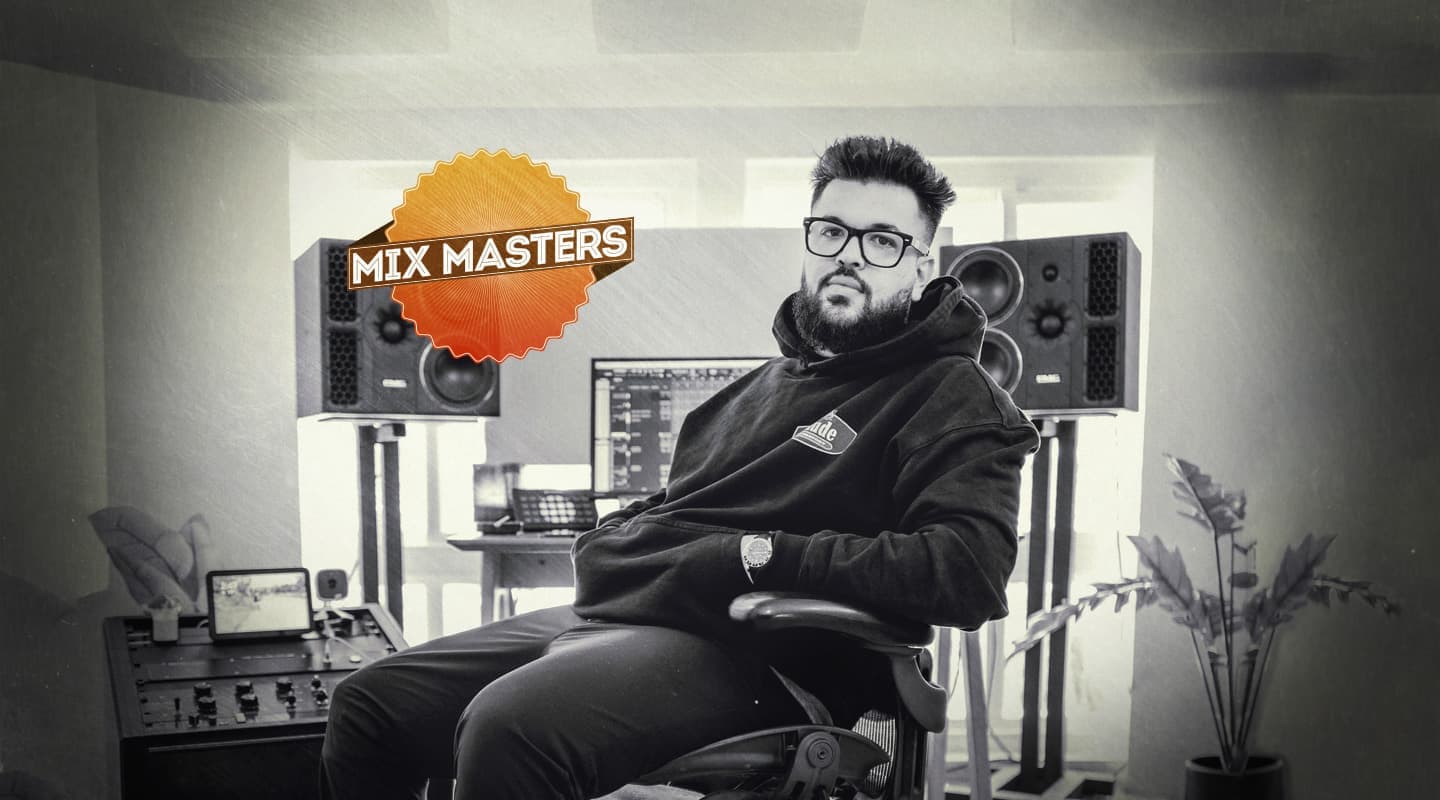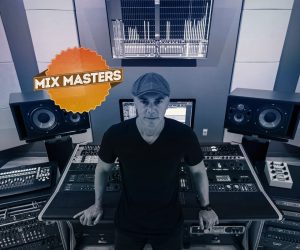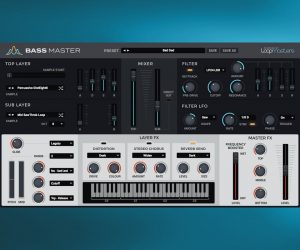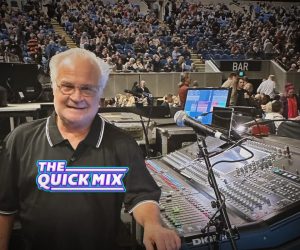
Mix Masters: Industry Baby
Mix engineer ‘Teezio’ Pigliapoco walks us step by step through his (Grammy nominated) mix process for this chart topper from Lil Nas X.
When Lil Nas X broke through in 2019 with his megahit ‘Old Town Road’, there was incredulity that it was possible for an unsigned artist to make it big via TikTok, and also speculation that the barely 20-year-old rapper was peaking too quickly, too soon, and would prove to be a one-hit wonder. Less than three years later, he’s had a No.1 hit album, ‘Montero’, a hit-EP, ‘7’, and seven hit songs, including two No.1s, totalling 31x platinum sales in the US and 19x platinum sales in Australia.
All this is a stunning triumph for Lil Nas X, and a sign of the future of the music industry. What’s more, he’s achieved it with insanely catchy tracks that sound different from everything else in the charts at the moment. A case in point is the American and Australian No.1 ‘Industry Baby’. Produced by production duo Take A Daytrip and Kanye West, the song is propelled by a unique and baroque-sounding horn section that underpins Lil Nas X’s rapping and massed vocals, plus a rap by Jack Harlow.
In another possible change of guard, ‘Industry Baby’ was mixed by Patrizio ‘Teezio’ Pigliapoco. As everyone knows who follows what happens in the hit music industry, the top songs in the world, particularly the US, are mixed by a very small group of top mixers. First among them is Serban Ghenea, followed by Manny Marroquin, and after that pair, half a dozen mixers with fairly equal standing. Ghenea and Marroquin mixed four songs each on ‘Montero’. Pigliapoco mixed two, and the fact that he mixed one of the two main singles is pretty unusual.
Talking via Zoom from his studio in Los Angeles, Pigliapoco explains that he’s been incredibly lucky, as the pandemic was for him a period of “nothing but incredible growth! Until 2019, I worked mainly as Chris Brown’s engineer and mixer, but since then I started mixing full-time, and 2020 was great and 2021 even better! I have four Grammy nominations for the 2022 ceremony. [Album of the Year for Lil Nas X and H.E.R, Best Melodic Performance for ‘Industry Baby’, and Best R&B album for H.E.R.] Hopefully this year will be another improvement!”
RISING FROM A SOLID BASS
Pigliapoco was born in Los Angeles in 1990 from Argentinian parents, and grew up playing bass. When he was around 16, he recognised that the future was going to be digital, and he ended up interning at a label and recording studio not far from his school. It inspired him to attend The Los Angeles Recording School, and he graduated there with honours. During his time at the school he got a job engineering for rapper Juicy J, at Wyman studios, where the owner, Tip Wyman, became a mentor.
At 21, Pigliapoco signed a publishing deal with BMG as an engineer and producer. He worked with Cheryl Cole on her album ‘A Million Lights’ (2012), and with Fergie on her album ‘Double Dutchess’ (2017). He also worked with Josh Gudwin (engineer and mixer for Justin Bieber), and in 2015 Pigliapoco became the regular engineer for Chris Brown. He eventually graduated to also finding the beatmakers and producers for Brown’s albums, doing production, and mixing the final tracks.
Pigliapoco still works with Brown, but has over the last two years spread his wings and has mixed tracks for an impressive number of artists, among them The Kid Laroi, Pop Smoke, Gunna, DJ Khaled, Polo G, G-Eazy, H.E.R., Mooski, Chris Brown, and, of course Little Nas X, which gave him his first Billboard No.1, and two Grammy nominations. Pigliapoco clearly is breaking into the elite group of star mixers.
HYBRID STUDIO LOW DOWN
One result of Pigliapoco’s success is that he’s been able to buy a new house in Los Angeles, where he has installed a state-of-the-art hybrid studio. “My monitors are the PMC 6-2,” he explains. “I used to have the PMC 226 monitors, and the 6-2’s are essentially double. They have incredible low end. I think they go down to 10Hz or something like that, so I don’t need a sub. These things are insane! My room is 10x15ft, and I have the low end down by 7dB to make it work in the room. I use the Grace m905 monitor controller.
“I have a Mac with Pro Tools and my interface is the Lynx Aurora 24 I/O. This allows me to use channels 1 and 2 for my stereo output, 3 and 4 for the rough mix, 5 and 6 go to my D.W Fearn VT5 EQ, 7 and 8 go to my Undertone Audio Unfairchild 670M II, and 9 to 24 go to my Neve 5057 Orbit 16-channel summing mixer. I send eight stereo pairs to the Neve, which are the group tracks near the top of my Pro Tools sessions: drum bus, music bus, effect bus, and vocal buses.
My version is going to sound way better, it is going to hit harder, it is going to be more dynamic, but as a general rule, the blend needs to match the rough



Teezio relies on a select collection of outboard including a D.W Fearn VT5, an Undertone Audio Unfairchild 670M II, and a Neve 5057 Orbit summing mixer.
“I have the outboard because of the sonics. It gives me a sound that I cannot get any other way. For example, the VT5 is on the insert of my master bus, and it takes out any abrasiveness in the top end. It’s incredible. Often when you are mixing, you are struggling to tame things that are too bright. Particularly when you are dealing with vocals today — people often boost the top end too much. Just running the signal through the VT5 flat corrects that. Rather than fighting with EQs and multiband compressors in the box, it’s a lot easier just to run your entire mix through the VT5 and a lot of that work is done for you.
“I use the Unfairchild on the vocals, as my first vocal compressor, and then I commit that. Songs tend to have verse, pre-hook and hook sections, and usually a lead vocal is on two tracks, because sometimes things will overlap. So I’ll work one vocal track of the verse on Channel 7 and the other vocal track on Channel 8, and then I’ll commit that, which frees up these two channels to work on the pre- or the hook lead vocal.”
BABY STEPS: MIX WALK THROUGH
Pigliapoco illustrates his process with his mix of ‘Industry Baby’. He recalls, “The production session was done in Logic, and I was sent audio files that were all printed. So there were no plugins. I asked the producers, Take A Daytrip, to send me the lead vocals with only Antares AutoTune applied, and the effects printed separately. When people send you tracks with effects like reverb, when you start compressing and EQ-ing them, the reverb changes. Having the effects separate gives me more control. In general I did use many of the delays and reverbs that they sent, because they wanted specific delays in specific places.
“I loaded all their audio files into Pro Tools, which made it easier, because actually, receiving a session this big as a Pro Tools session would have been really difficult. It would have been a lot of work to make that fit my workflow. There would have been plugins everywhere, and AutoTune on every track, and it would have become an enormous session. Instead I could import the audio in a fresh Pro Tools session, in which I could work more cleanly.
“They also sent me a rough, which sounded pretty good, as is the case when you’re dealing with high calibre artists and producers. I normally follow the rough very closely. In fact, I reference the rough all the time. I will listen to the rough for 20 seconds, just to get an idea of how much low end there is, how much compression is happening overall, how bright the vocals are, and how loud the mix is. If the mix is printed at -5 LUFS, I am going to have a really tough time getting my mix to sound really good and dynamic and as loud.
“Once I get the idea of the rough, I pull in the drums and I start referencing back and forth between the rough and my mix, constantly, to make sure I get a similar blend. Are the kick and the snare in the same place? Of course, that does not mean that if something sounds too loud for me, that I won’t turn it down. After the drums I pull in the bass, and listen again to the rough. Where is the bass? How loud is it? Is my bass louder? How loud is the music?
“My version is going to sound way better, it is going to hit harder, it is going to be more dynamic, but as a general rule, the blend needs to match the rough. If your 808 or bass is not hitting as hard, your mix won’t feel as big and dynamic. So referencing is the most important thing. I don’t want to go in the wrong direction.
“If the strings are the main part in the song, and I have them too low, the energy will go down. I also need to control the vocals. Usually they are too bright in the rough, so I need to find that middle place where they are bright enough, but not abrasive. In other words: balance what they have, and make it sound better.
“Sometimes people tell me: ‘don’t listen to the rough. The engineer did not get it right, do your thing.’ Of course, I’m happy to do that, but what they don’t know is that I will still reference the rough, just to get an idea of where things are. Think about it: maybe the A&R tells me not to listen to the rough, but an artist who does not have as much knowledge of mixing may like the rough. If I’m lucky, I get to speak with the artist as well, and they can tell me what they think of the rough. I have to have all these things in my head when I’m mixing.”

OBSESSIVE COMPULSIVE ORDER
Pigliapoco’s mix session of ‘Industry Baby’ is huge, about 200 tracks, and very well-organised. At the top are his master track, called Neve Return, Mix Buss, Mix prints, Rough Mix, the aforementioned eight groups that are sent to the Neve and his aux tracks. This entire section is part of his template. Below this are the audio tracks and some associated aux tracks: drums, bass, music, vocals, and a 90-track, four-bar horn outro in pink.
“I am very OCD,” explains Pigliapoco. “Everything has to be very well organised. The master fader is at the top, because it is the master! Everything at the bottom feeds the tracks at the top. I don’t like having things like aux effects tracks at the bottom, as many people have. So the audio tracks feed the yellow bus tracks, which go to my Neve 5057, and then come back on my Neve Return, which is sent to my mix bus track.”
Before elaborating further on the top of his mix session, Pigliapoco follows the signal flow of his session, and his mix process, by first discussing his treatments on the audio tracks. “I put the tracks in the order in which I mix them, so I’m literally working my way down as I am mixing. So first there are my drums, in blue, because I start with them. They are the most important part of the session. And at the top of the drums is the kick.
“A lot of my work on the drums and other audio tracks is done with the Fabfilter Pro-Q3, which is my starting point for EQ, and I tend to notch out frequencies I don’t want. I always start with that, before I start boosting frequencies. First take out the bad stuff! I also use the iZotope Neutron 3 for this, which I adore. It is really easy to use, and allows you to split the compression into bands. So if the transient part of the kick is too bright, I can split the compressor into two frequencies and affect the low end and the high end differently.
“Those are my main two plugins on many audio tracks. There’s also a Waves Doubler on a reversed cymbal, because I wanted it wider. The Audio tracks usually feed the aux group tracks below them, and all drums go to the Drums bus track, on which I have the Acustica Audio Mike Dean Gainstation, doing 0.1 on the Clipper, which seems very minimal, but it makes a big difference, and adds drive. After that I have the Softube Weiss limiter, which I use to push the volume on the drums. I also have the iZotope Ozone, but I did not use it in this case. I love the iZotope stuff, because it’s really clean and transparent. I use many plugins, and don’t want too many that add colour, otherwise you end up with a mess.”
BASS TRACK HACKS
Pigliapoco continues his exposé by tackling the six bass tracks, which are coloured brown. Three of which have 808s. “Usually there are only two bass tracks, but there are quite a few here! Most of these low-end tracks again have the Pro-Q3, and with the 808s I’m often notching around 200Hz and 400Hz, where they can sound boxy. In this case there’s a 1dB notch at 59Hz and at 104Hz. After that I’m using the Avid lo-fi plugin for some distortion and then I throw on the Waves MV2 Limiter, boosting both high level and low level. After that there’s a Neutron 3.”
The green music tracks consist of horns, which are in part played, despite many suspecting a looped sample. “Yeah, it’s a very extensive arrangement, with trombones, tubas, trumpets, saxophones and so on. I again use the Pro-Q3 extensively, with tons of notches to take away some abrasive frequencies. You can see this in the image of the Pro-Q3 on the main horn loop, which is the first green track below the bass tracks. That horn loop also has the Celestian Psychoacoustic Bus Processor, which is adding harmonics with the Teal Staging Harmonics knob, and widens the signal with the Yellow Stereo Elliptic knob. After that there’s some compression from the Waves CLA-3A.

“All horns go to a Horns Group aux, and then to the Music bus at the top. I don’t normally have plugins on the Music bus because there tend to be so many different elements in the music, and I prefer to treat each separately. Underneath the Horns Group aux is a track called Outro, in blue, which is the submix of the 60-track entire horn section at the bottom of the session in pink. I had to commit that down and then deactivate the original tracks, because the session would otherwise have been too big. Also, the blend was already there, so I did not want to disturb that.
“Below the Outro track are some tracks in brown, which are vocal effects, like ad libs, and they were more part of the music, which is why I placed them there. They go to the BGV group bus at the top. Below this are Nil Nas X’s main sung vocals in light blue, one hook track and three verse tracks, and two tracks down, in dark blue, his rap (verse2). They all they have largely the same signal chain, but settings change between the verse and the hook.”
“In the prehook (vpreld) I was cutting less low end. Because there are no drums at that point, I left more body in the vocals. Whenever an element drops out of the mix, other elements become heightened. So if the kick drops out, all of a sudden you are going to be more focused on the more high-end elements and there’s space for low end. You have to balance things, and to do this I used an extra plugin here, the FabFilter Pro-MB multiband compressor.

“For the rest, the UAD Pultec EQP -1A does a 10-12kHz boost, and I have the Waves CLA76, because I wanted a compressor that was really aggressive and dirty, and pumped. I don’t usually use the CLA76, but this song needed a compressor that was really aggressive and dirty. They wanted the vocal to sound like that. Today, I use the Unfairchild at the point where the CLA76 is in this session, but I did not have that unit at the time I mixed this.
“Another important plugin I used on the vocals was Overloud’s Gem Dopamine Audio Enhancer. It heightens and boosts the top end in a nice way. After that I put on the Oeksound Soothe 2, to tame all the top end I just boosted. There’s also a de-esser and the Neutron, which is out taking some bottom end.
“And finally there’s the Pro-C2 compressor, which is usually the last compressor I have in the chain. It’s another plugin that is intuitive and easy-to-use, which is very important to me. If it is a complicated plug-in I don’t really want to deal with it. There is a lot of stuff going on already as it is, and to have to learn something that is overly complicated is not worth the time.
“There are three sends on these lead vocals, one to my Seventh Heaven aux effects track, which has the LiquidSonics Seventh Heaven Convolution Reverb. It mimics the Bricasti. There’s also a send to my effects aux track with the Valhalla Vintage Verb, and another to an aux with the SoundToys Microshift. I blend my reverbs, instead of relying on one reverb to give me specific sound. I will often also EQ the reverb afterwards. On the Seventh Heaven I cut all the low end information, because it was clouding up the mix a little bit.”
VOCALS: STACKS ON
Below Lil Nas X’s lead vocals are stacks and stacks of background vocals, and below them, at the bottom of the session and just above the deactivated tracks, is Jack Harlow’s rap. “As I mentioned earlier, the audio tracks are sent to the aux track below them. There are tons and tons of vocal layers. The hook alone is reinforced with eight vocals. In this session, rather than work on individual tracks, I processed the aux group tracks, and tried to preserve the blends and vibe that was there. I am boosting less at 10kHz on the stacks, because I want the lead vocals to be prominent, and for the backgrounds to have a warmer sound. There’s also a Neutron 3 cutting around 2.5kHz, again to soften the stacks.”

Returning to the top of the session, Pigliapoco elaborates on the rough mix and mix bus tracks. “The red track with the pink clip called ‘Industry12324808’ is the rough mix, which came in at -9.6 LUFS, which is what I want. I always want my mix to be louder than the rough, and if the rough is extremely loud it leaves me no space to work with. When I put the vocals in, I’m already at -9 LUFS, and from there I only need another -2 dB. I can actually come in at -.5.5 LUFS before distortion, boosting everything little by little.

“On the mix bus I have the Acustica Audio Ruby, which is the plugin version of my VT5. I loved the Ruby so much that I got the real deal after I mixed this song! After that I have a Pro-Q3, and then the Brainworx bx_digital V3 EQ, to notch out some weird frequencies. It is a great piece of gear. Finally there’s the Shadow Hills Mastering Compressor, and then the UAD Sonnox Oxford Limiter, for volume. I take that off when I send the mix for mastering.
“‘Industry Baby’ was mastered by Eric Lagg. When Pigliapoco sent it off, did he think the song would blow up like it did? “No. I know of course that every song Lil Nas releases does well, so I anticipated it being a hit, but not that it’d go to No.1 in the US. It’s been incredible, and I am blessed!”
















RESPONSES